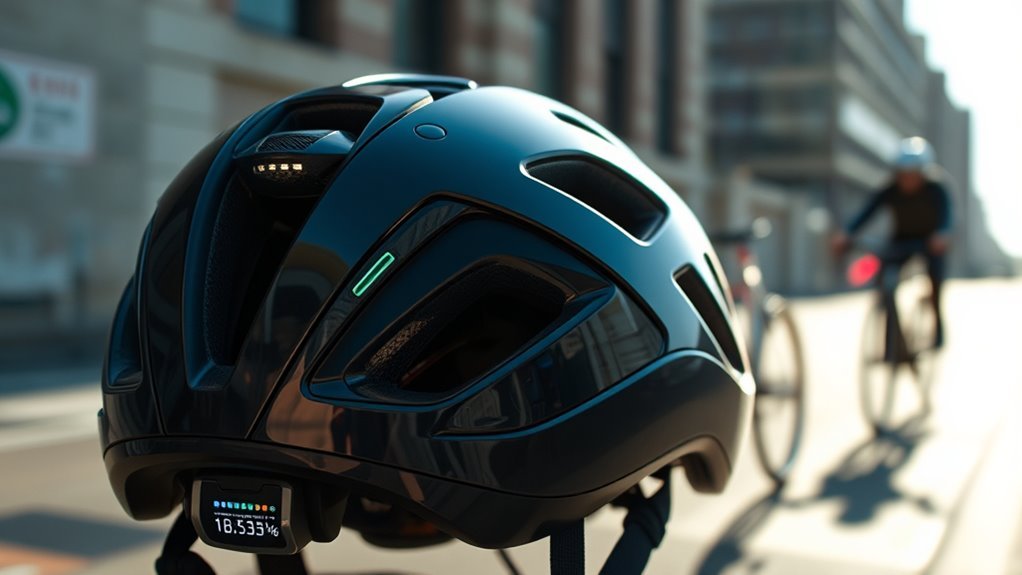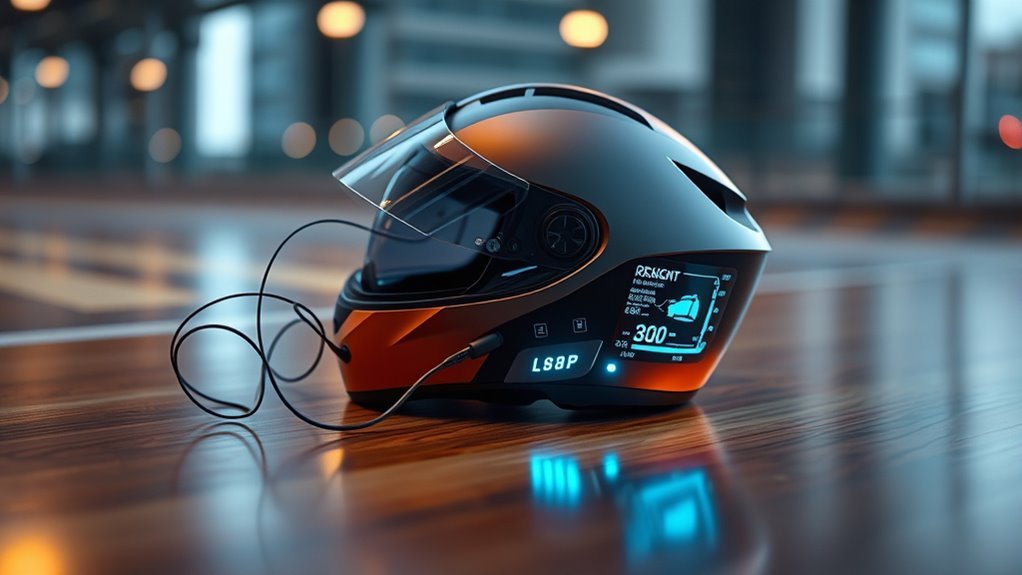Smart Helmet Sensors: Detecting Crashes in Real-Time
Smart helmet sensors revolutionize rider safety by detecting crashes in real-time. They use accelerometers and gyroscopes to monitor speed and head movements, allowing immediate alerts to emergency services. This quick response can minimize injury severity and save lives. Additionally, crash data can help identify risky behavior and improve overall riding awareness. With these advancements, you can contribute to a safer environment. Discover how these innovations continue to shape the future of safety gear.
How Smart Helmet Sensors Work

While you might think of helmets as simple protective gear, smart helmet sensors are revolutionizing safety by integrating advanced technology. These innovative devices utilize sensor functionality to monitor your head’s movements and environmental conditions. Embedded accelerometers and gyroscopes track your speed and orientation, providing real-time data. When a crash occurs, sophisticated crash algorithms analyze the forces involved, evaluating the potential severity of the impact. This instantaneous feedback can be essential for emergency response, ensuring you get the help you need swiftly. With the right data, smart helmets empower you to enjoy your freedom while enhancing your safety on the road or trail. These advancements are a confirmation of how technology can elevate our experiences without compromising our adventurous spirit.
Benefits of Real-Time Crash Detection

Real-time crash detection can be a game changer for your safety, as it provides immediate alerts and responses in critical situations. With smart helmet sensors, you’re not just wearing protective gear; you’re integrating technology that prioritizes your well-being. These real-time alerts can notify emergency services within seconds, potentially saving your life or reducing injury severity. Furthermore, the ability to analyze crash data helps in accident prevention by identifying high-risk areas and behaviors, empowering you with the knowledge to ride more safely. This proactive approach allows you to enjoy your freedom on the road while minimizing risks. With real-time crash detection, you’re not just reacting to accidents; you’re actively working to avoid them altogether.
The Technology Behind Smart Helmet Sensors

Smart helmet sensors are revolutionizing the way we think about safety on the road. These innovative devices utilize advanced sensor technology to monitor your movements and detect potential crashes in real-time. When you’re out there enjoying the freedom of the open road, you can trust that:
- Accelerometers track sudden changes in speed.
- Gyroscopes measure the helmet’s orientation and stabilization.
- Crash algorithms analyze data to predict collisions.
This combination empowers your helmet to make split-second decisions, alerting emergency services if needed. By integrating smart technology into your gear, you’re not just riding; you’re riding smarter. With the right technology, you can embrace your adventures while keeping safety at the forefront without compromising your sense of freedom.
Safety Impact on Cyclists and Motorcyclists
As you navigate bustling streets or winding country roads, the safety impact of smart helmet sensors on cyclists and motorcyclists becomes increasingly evident. These sensors enhance motorcyclist awareness by providing real-time data about their surroundings, allowing for quicker reactions to potential hazards. For cyclists, the technology encourages safer behaviors, promoting a more cautious approach to riding. Imagine receiving alerts about nearby vehicles or sudden obstacles, enabling you to adjust your riding strategy instantly. This heightened awareness can greatly reduce accidents, creating a safer environment. By adopting smart helmets, you’re not just improving your own safety; you’re contributing to a culture of responsibility and vigilance among all road users, fostering a sense of freedom without compromising well-being.
Integration With Emergency Services
While you’re out traversing the roads, the integration of smart helmet sensors with emergency services can make an important difference in how quickly help arrives during an incident. These helmets don’t just detect crashes; they also facilitate seamless communication with emergency response teams, ensuring swift action when you need it most.
The integration of smart helmet sensors with emergency services ensures swift assistance during incidents, enhancing your safety on the road.
- Instant alerts sent to nearby ambulances
- GPS tracking for precise location
- Real-time health data transmission
This service collaboration means responders can arrive prepared, equipped with crucial information about your condition. With smart helmets, your safety isn’t just in your hands; it’s linked to a network ready to act. Embrace the freedom of the open road, knowing help is just a sensor away.
The Future of Smart Safety Gear
The evolution of safety gear is set to redefine how we think about protection on the road. Imagine wearing a smart helmet equipped with cutting-edge wearable technology that continuously monitors your environment. These innovations aren’t just about comfort; they’re pivotal for injury prevention. As the future unfolds, you’ll see gear that not only detects crashes in real-time but also provides instant feedback, enhancing your riding experience. Integration with apps can offer personalized safety tips based on your riding habits. With this kind of technology, you’re not just wearing protection; you’re embracing a smarter, more connected lifestyle. The road ahead is brighter, as these advancements empower you to ride freely, knowing that your safety gear has your back.
Frequently Asked Questions
Can Smart Helmet Sensors Be Used for Sports Other Than Cycling or Motorcycling?
Absolutely, smart helmet sensors can be utilized in various sports beyond cycling and motorcycling. In rugby safety, these sensors can detect impacts, helping coaches and trainers monitor players’ well-being. Similarly, in football technology, they can enhance player safety by providing real-time data on head collisions. This innovation not only promotes safety but also gives athletes the freedom to focus on performance without the constant worry of hidden injuries. It’s a game-changer!
How Do Smart Helmet Sensors Affect Battery Life and Usage?
Smart helmet sensors can greatly impact battery life and usage. If you’re using advanced sensors, you’ll notice that their battery efficiency varies based on the technology and features employed. For instance, sensors with optimized power management can enhance sensor longevity, allowing you to enjoy longer rides without frequent recharging. However, if you’re using features like GPS tracking, it might drain the battery faster. Balancing functionality and battery performance is key to maximizing your experience.
Are Smart Helmets Compatible With Other Wearable Technology?
Think of smart helmets as the bridge that connects various islands of wearable technology. Yes, they’re compatible with other devices, allowing for seamless wearable integration. You can sync them with smartwatches, fitness trackers, or even smartphones, enhancing your experience and safety. This technology compatibility means you can monitor your health metrics or receive notifications without missing a beat, giving you the freedom to focus on your ride while staying connected.
What Is the Cost Range for Smart Helmets With Crash Detection?
Smart helmets with crash detection typically range from $150 to $600. If you’re looking for affordable options, you’ll find basic models that still offer essential safety features. However, if you want premium features like advanced sensors and connectivity, expect to pay more. Investing in a higher-end helmet can enhance your riding experience and safety, giving you peace of mind while enjoying the freedom of the open road. Choose wisely!
How Often Do Smart Helmet Sensors Need Updates or Maintenance?
You might think your smart helmet’s sensors are set and forget, but that’s not the case. Regular maintenance is essential; ideally, you should check sensor calibration every six months. Ignoring this could mean missing important crash detection. Consider how often you ride—if it’s frequent, more regular checks might be necessary. By staying on top of maintenance frequency, you guarantee your helmet’s ready to protect you when it matters most.






